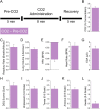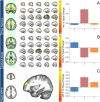The relationship between dlPFC activity during unpredictable threat and CO2-induced panic symptoms
- PMID: 29213110
- PMCID: PMC5802456
- DOI: 10.1038/s41398-017-0006-5
The relationship between dlPFC activity during unpredictable threat and CO2-induced panic symptoms
Abstract
Panic disorder is characterized by sudden, repeated, and unexpected attacks of intense fear and overwhelming anxiety about when another attack may strike. Patients with panic disorder and healthy individuals with a history of panic attacks show a hypersensitivity to unpredictable threats, suggesting a possible link between panic and sustained anxiety. The purpose of this study was to determine the degree to which induced symptoms of panic relate to fear and anxiety, as well as activity in the neural systems that mediate and regulate these affective states. Psychological and physiological symptoms of panic were assessed during an 8-min 7.5% CO2 challenge task. Psychological, physiological, and neural symptoms of fear and anxiety were measured during two sessions (one psychophysiology and one functional magnetic resonance imaging where subjects experienced several blocks of no threat (N), predictable shock (P), and unpredictable shock (U; NPU threat task). We used a principle component analysis to characterize panic susceptibility (PS), and found that PS significantly predicted dorsolateral prefrontal cortex (dlPFC) activity to the unpredictable cue during the NPU threat task. When examining the weighted beta coefficients from this analysis, we observed that self-reported fear/anxiety during the CO2 challenge negatively loaded onto dlPFC activity during the NPU task. Consistent with this observation, dlPFC activity during the unpredictable cue was also negatively correlated with anxiety during the NPU sessions. Together, these results suggest that panic symptoms and anxiety are regulated by the same prefrontal cognitive control system.
Trial registration: ClinicalTrials.gov NCT00047853.
Conflict of interest statement
The authors declare that they have no competing financial interests.
Figures




Similar articles
-
Gender differences in anxiety: The mediating role of sensitivity to unpredictable threat.Int J Psychophysiol. 2020 Jul;153:127-134. doi: 10.1016/j.ijpsycho.2020.05.001. Epub 2020 May 14. Int J Psychophysiol. 2020. PMID: 32417225 Free PMC article.
-
Effect of Threat on Right dlPFC Activity during Behavioral Pattern Separation.J Neurosci. 2017 Sep 20;37(38):9160-9171. doi: 10.1523/JNEUROSCI.0717-17.2017. Epub 2017 Aug 21. J Neurosci. 2017. PMID: 28842415 Free PMC article.
-
Commonalities and differences in the neural substrates of threat predictability in panic disorder and specific phobia.Neuroimage Clin. 2017 Feb 20;14:530-537. doi: 10.1016/j.nicl.2017.02.013. eCollection 2017. Neuroimage Clin. 2017. PMID: 28331799 Free PMC article.
-
Five percent carbon dioxide challenge: valid analogue and marker of panic disorder?Biol Psychiatry. 1990 Apr 1;27(7):689-701. doi: 10.1016/0006-3223(90)90584-o. Biol Psychiatry. 1990. PMID: 2109638 Review.
-
The impact of startle reactivity to unpredictable threat on the relation between bullying victimization and internalizing psychopathology.J Psychiatr Res. 2019 Dec;119:7-13. doi: 10.1016/j.jpsychires.2019.09.004. Epub 2019 Sep 6. J Psychiatr Res. 2019. PMID: 31520836 Free PMC article. Review.
Cited by
-
The emotional brain: Fundamental questions and strategies for future research.Neurosci Lett. 2019 Feb 6;693:68-74. doi: 10.1016/j.neulet.2018.10.012. Epub 2018 Oct 20. Neurosci Lett. 2019. PMID: 30473315 Free PMC article.
-
Intermittent theta-burst stimulation to the right dorsolateral prefrontal cortex may increase potentiated startle in healthy individuals.Neuropsychopharmacology. 2024 Sep;49(10):1619-1629. doi: 10.1038/s41386-024-01871-w. Epub 2024 May 13. Neuropsychopharmacology. 2024. PMID: 38740902 Free PMC article. Clinical Trial.
-
Proof of concept study to develop a novel connectivity-based electric-field modelling approach for individualized targeting of transcranial magnetic stimulation treatment.Neuropsychopharmacology. 2022 Jan;47(2):588-598. doi: 10.1038/s41386-021-01110-6. Epub 2021 Jul 28. Neuropsychopharmacology. 2022. PMID: 34321597 Free PMC article.
-
Orbitofrontal and Prelimbic Cortices Serve Complementary Roles in Adapting Reward Seeking to Learned Anxiety.Biol Psychiatry. 2024 Nov 1;96(9):727-738. doi: 10.1016/j.biopsych.2024.02.1015. Epub 2024 Mar 7. Biol Psychiatry. 2024. PMID: 38460582
-
Hippocampal Representation of Threat Features and Behavior in a Human Approach-Avoidance Conflict Anxiety Task.J Neurosci. 2020 Aug 26;40(35):6748-6758. doi: 10.1523/JNEUROSCI.2732-19.2020. Epub 2020 Jul 21. J Neurosci. 2020. PMID: 32719163 Free PMC article.
References
-
- American Psychiatric Association. Diagnostic and Statistical Manual of Mental Disorders: Dsm-5 (Amer Psychiatric Pub Incorporated, Arlington, VA, 2013).
-
- Battaglia M, Ogliari A, D’Amato F, Kinkead R. Early-life risk factors for panic and separation anxiety disorder: insights and outstanding questions arising from human and animal studies of CO2 sensitivity. Neurosci. Biobehav. Rev. 2014;46:455–464. doi: 10.1016/j.neubiorev.2014.04.005. - DOI - PubMed
Publication types
MeSH terms
Substances
Associated data
Grants and funding
LinkOut - more resources
Full Text Sources
Other Literature Sources
Medical

